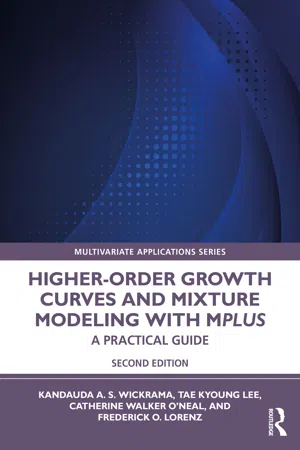
Higher-Order Growth Curves and Mixture Modeling with Mplus
A Practical Guide
- 326 pages
- English
- ePUB (mobile friendly)
- Available on iOS & Android
Higher-Order Growth Curves and Mixture Modeling with Mplus
A Practical Guide
About This Book
This practical introduction to second-order and growth mixture models using M plus introduces simple and complex techniques through incremental steps.
The authors extend latent growth curves to second-order growth curve and mixture models and then combine the two using normal and non-normal (e.g., categorical) data. To maximize understanding, each model is presented with basic structural equations, figures with associated syntax that highlight what the statistics mean, M plus applications, and an interpretation of results. Examples from a variety of disciplines demonstrate the use of the models and exercises allow readers to test their understanding of the techniques. A comprehensive introduction to confirmatory factor analysis, latent growth curve modeling, and growth mixture modeling is provided so the book can be used by readers of various skill levels. The book's datasets are available on the web.
New to this edition:
* Two new chapters providing a stepwise introduction and practical guide to the application of second-order growth curves and mixture models with categorical outcomes using the M plus program. Complete with exercises, answer keys, and downloadable data files.
* Updated illustrative examples using M plus 8.0 include conceptual figures, M plus program syntax, and an interpretation of results to show readers how to carry out the analyses with actual data.
This text is ideal for use in graduate courses or workshops on advanced structural equation, multilevel, longitudinal or latent variable modeling, latent growth curve and mixture modeling, factor analysis, multivariate statistics, or advanced quantitative techniques (methods) across the social and behavioral sciences.
Frequently asked questions
Information
Table of contents
- Cover
- Endorsements
- Half-Title
- Series
- Title
- Copyright
- Contents
- Preface
- Acknowledgments
- Authors
- PART I Growth Curve Modeling
- PART II Growth Mixture Modeling
- PART III Latent Growth Curves with Non-Normal Variables
- 10 Latent Growth Curve Model with Non-Normal Variables
- 11 Growth Mixture Models with Non-Normal Variables
- Answers to Chapter Exercises
- Index